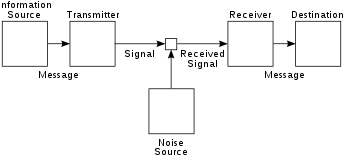通信的数学理论
外观
| 通信的数学理论 | |
|---|---|
 1949年全文版 | |
| 作者 | 克劳德·E·香农 |
| 语言 | 英文 |
| 主题 | 通信理论 |
| 出版資訊 | |
| 初刊載處 | 贝尔系统技术学报 |
| 出版日期 | 1948 |
| 出版地 | 美国 |
《通信的一种数学理论》(A Mathematical Theory of Commuication)是数学家克劳德·香农于1948年在《贝尔系统技术期刊》上发表的一篇文章。[1][2][3] [4]在意识到这项工作的普遍性之后,它在1949年的同名书籍中被重新命名为《通信的数学理论》(The Mathematical Theory of Commuication),[5]这个标题变化虽小,但意义重大。这篇论文因为催生了信息论领域,被引用数万次,是有史以来最具影响力和被引用次数最多的科学论文之一。 [6] 《科学美国人》称该论文为“信息时代的大宪章”, [7]而电气工程师罗伯特·加拉格称其为“数字时代的蓝图”。[8]历史学家詹姆斯·格雷克将这篇论文评为1948年最重要的发展,晶体管位居同一时期的第二位。格雷克强调,香农的论文“甚至比晶体管更深刻、更基础”。 [9]
文中还指出,“如同相对论和量子论一样,信息论从根本上改变了科学家看待宇宙的方式”。 [10]论文还正式引入了“比特”一词,作为其理论基础。 [11]
发布
[编辑]这篇文章是信息论领域的奠基之作。它后来于1949年出版,书名为《通信的数学理论》(ISBN 0-252-72546-8),该书于1963年以平装本形式出版(ISBN 0-252-72548-4)。本书还收录了沃伦·韦弗(Warren Weaver)的一篇附加文章,为更广泛的读者提供了该理论的概述。 [12]
内容
[编辑]
香农的文章列出了通信的基本要素:[5]
- 产生消息的信息源
- 发射器对消息进行操作,以创建可通过信道发送的信号
- 信道是发送承载构成消息的信息的信号的媒介
- 接收器,将信号转换回要传递的信息
- 目的地,可以是人或机器,是消息的目的地
它还发展了信息熵、冗余度和信源编码定理的概念,并引入了“比特” (香农将其归功于约翰·图基)作为信息单位。香农-法诺编码技术也是在这篇论文中提出的——该技术由香农与罗伯特·法诺共同开发。[5]
参考文献
[编辑]- ^ Shannon, Claude Elwood. A Mathematical Theory of Communication (PDF). Bell System Technical Journal. July 1948, 27 (3): 379–423. doi:10.1002/j.1538-7305.1948.tb01338.x. hdl:11858/00-001M-0000-002C-4314-2
 . (原始内容 (PDF)存档于1998-07-15).
. (原始内容 (PDF)存档于1998-07-15). The choice of a logarithmic base corresponds to the choice of a unit for measuring information. If the base 2 is used the resulting units may be called binary digits, or more briefly bits, a word suggested by J. W. Tukey.
- ^ Shannon, Claude Elwood. A Mathematical Theory of Communication. Bell System Technical Journal. October 1948, 27 (4): 623–656. doi:10.1002/j.1538-7305.1948.tb00917.x. hdl:11858/00-001M-0000-002C-4314-2
 .
.
- ^ Ash, Robert B. Information Theory: Tracts in Pure & Applied Mathematics. New York: John Wiley & Sons Inc. 1966. ISBN 0-470-03445-9.
- ^ Yeung, Raymond W. The Science of Information. Information Theory and Network Coding
 . Springer. 2008: 1–4. ISBN 978-0-387-79233-0. doi:10.1007/978-0-387-79234-7_1.
. Springer. 2008: 1–4. ISBN 978-0-387-79233-0. doi:10.1007/978-0-387-79234-7_1.
- ^ 5.0 5.1 5.2 Shannon, Claude Elwood; Weaver, Warren. The Mathematical Theory of Communication (PDF). University of Illinois Press. 1949. (原始内容 (PDF)存档于1998-07-15).
- ^ Yan, Zheng. Publishing Journal Articles: A Scientific Guide for New Authors Worldwide. Cambridge University Press. 2020: 7. ISBN 978-1-108-27742-6 (英语).
- ^ Goodman, Rob; Soni, Jimmy. Genius in Training. Alumni Association of the University of Michigan. 2018 [2023-10-31]. (原始内容存档于2025-07-11) (美国英语).
- ^ Claude Shannon: Reluctant Father of the Digital Age. MIT Technology Review. 2001-07-01 [2024-06-26]. (原始内容存档于2020-12-10) (英语).
- ^ Gleick, James. The Information: A History, a Theory, a Flood 1st. New York: Vintage Books. 2011: 3–4 [2025-07-31]. ISBN 978-1-4000-9623-7. (原始内容存档于2025-06-27) (英语).
- ^ Watson, Peter. Convergence: The Idea at the Heart of Science. New York London Toronto Sydney New Delhi: Simon & Schuster. 2018: 392. ISBN 978-1-4767-5434-5 (英语).
- ^ Nicolelis, Miguel A. L. The True Creator of Everything: How the Human Brain Shaped the Universe as We Know it. New Haven: Yale University Press. 2020: 34. ISBN 978-0-300-24463-2. OCLC 1090423259 (英语).
- ^ The Mathematical Theory of Communication (PDF). Monoskop Digital Libraries. [28 May 2024].
外部链接
[编辑]- (PDF) "A Mathematical Theory of Communication" by C. E. Shannon (reprint with corrections) hosted by the Harvard Mathematics Department, at Harvard University
- Original publications: The Bell System Technical Journal 1948-07: Vol 27 Iss 3. AT & T Bell Laboratories. 1948-07-01: 379–423 (英语).AT & T Bell Laboratories. 1948-07-01. pp. 379–423., The Bell System Technical Journal 1948-10: Vol 27 Iss 4. AT & T Bell Laboratories. 1948-10-01: 623–656 (英语).1948-10-01. pp. 623–656.
- Khan Academy video about "A Mathematical Theory of Communication"
